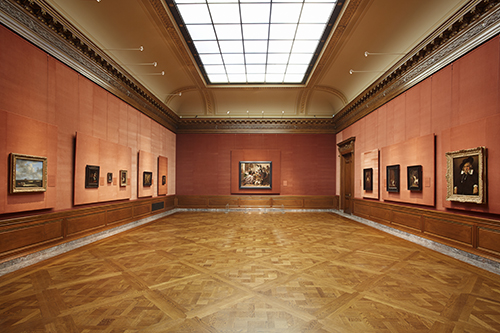Anita Jorgensen, IESNA, IALD, LEED, LC has been practicing architectural lighting design in New York for over twenty years. Her background in art history and theatrical lighting design brings a strong sense of aesthetics and drama to her lighting approach. Her hands-on experience gained from extensive exhibition lighting design work translates into specifications for lighting systems which not only meet the immediate lighting requirements, but also provide for durability, ease of maintenance, and long term flexibility. Anita was kind enough to answer a few questions about her work with the Gibbes Museum renovation.

How did you learn about the Gibbes Museum? I worked with Jeff Daly at The Metropolitan Museum for a number of years while he was the Head of the Department. When Jeff opened Jeff Daly Design, we worked on several projects together including: the Ringling Museum of Art; the annual Winter Antiques Show in New York; Rosecliff Mansion in Newport, RI; and others. In 2012 Jeff suggested I visit the Gibbes Museum and discuss its lighting needs with Angela Mack. Angela brought AJLD on board and I am happy to report that the Gibbes renovation has been a fabulous project with a fantastic team!
How did you get involved in lighting design? Give us a little information about what led you down this career path.
While studying Fine Arts and Art History in undergraduate school, I became aware of the work of renowned theatrical lighting designer Jennifer Tipton, who has designed for extensively for dance, drama and opera. Her work inspired me to pursue a career in theatrical lighting design. During my graduate studies at New York University Tisch School of the Arts, I became intrigued with the field of architectural lighting design. After five years with architectural lighting design firm Fisher Marantz Stone, who is best known for designing “Towers of Light” after the 911 twin towers incident, an opportunity arose to work as a lighting designer for the Metropolitan Museum of Art’s Design Department that I could not pass up. The projects I was involved with at the Metropolitan ranged from temporary exhibitions, large-scale renovations of entire wings, extensive custom case work, as well as exterior façade lighting.
After working on staff at the Metropolitan for a number of years, I began my own practice, Anita Jorgensen Lighting Design (AJLD).
What are the challenges with lighting museums? Please give examples. How can good lighting transform museum space?
One of the great challenges of designing lighting for museums is balancing art conservation standards with visual clarity. Among the many aspects to consider are the control of daylight while balancing supplemental glare free electric light. When designing the new lighting system for the East Gallery at The Frick Collection, which included both daylight and electric light, we completed an extensive mockup process to determine the optimal method for controlling the quantity of daylight entering the galleries in combination with supplemental LED lighting to highlight the artwork. The mockup process gives the team an opportunity to actually see and test the results of our research findings. We did the same for the Gibbes Museum where we reviewed the ability of various lighting sources to render paintings accurately. During a side by side lighting comparison in the galleries, it was unanimously decided that the track mounted luminaires would use 3,000 Kelvin LED sources. LED lamps have the great advantage of emitting no ultra violet radiation, consuming only 10 watts each as opposed to 50 watts and last more than seven times longer than halogen.

Another important consideration when designing for museums are issues of conservation. For example all of the windows need to be properly fitted with screens and filtering film to reduce the level of light entering the galleries and to block the damaging ultraviolet portion of the incoming daylight.
The second source of illumination in galleries is typically a fully flexible overhead track lighting system which is often the primary source for lighting art. For the first time, the track lighting in the new Gibbes Museum renovation will be energy-efficient LED (light-emitting diode) track mounted luminaires. After all of the artwork is installed, the gallery lighting will go through a final fine-tuning process. During this stage, the exact lighting intensity levels for each object will be specified.
We also recently completed an exterior night-time lighting mockup for the garden where we reviewed lighting the garden with cool light mimicking moonlight vs. warm candle light effect. We also demonstrated illuminating the trees from below (uplighting) vs. locating lights up in the trees pointed downwards filtering through the leaves that created patterns of light on the ground much like the light coming from a full moon.
What can the community expect to ‘see’ with the renovated Gibbes?
The visitor will be able to see the fabulous Gibbes Museum art collection rendered in a crisp new glare-free light. The galleries will be brighter and more daylight will enter the building giving the visitor a greater connection to the outside.
Below is a listing of Anita’s more memorable projects:
- Frick West Gallery, East Gallery: designed a new lighting system that integrates invisibly with the museum’s landmark interiors

- Metropolitan Museum Great Hall: recreation of the original McKim Meade and White pendants
- Royal Bank of Canada Capital Markets: a conference center and trading floor
Published June 16, 2015

